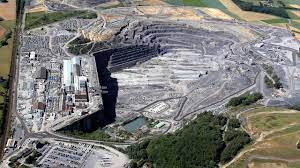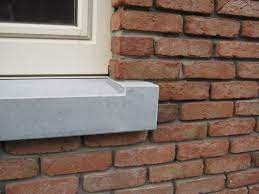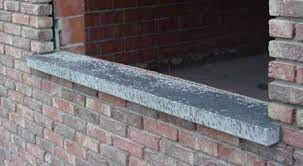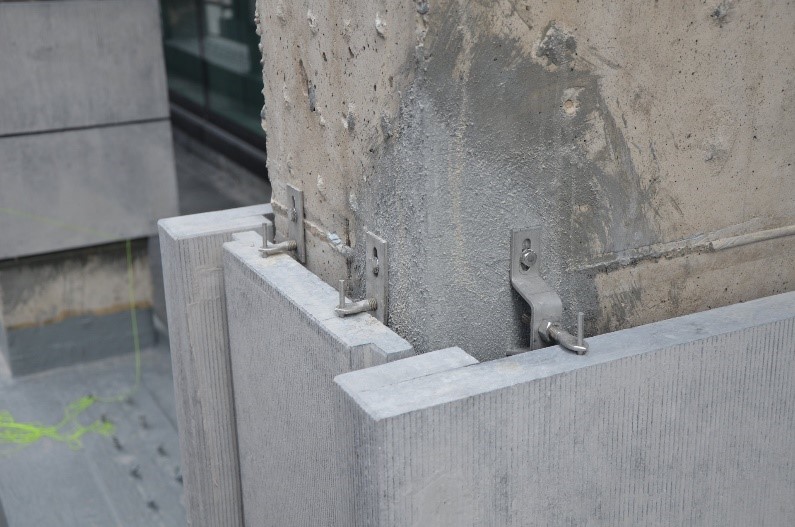Naturel stone, bluestone.
Belgian bluestone is durable and one of the best building and decorative materials in Europe.
The photo below shows a large pit in Hainaut, Belgium, where bluestone is being quarried.
What is the correct name of this pit?
Note that it is a French name.
Find the correct name on the internet.

1: Advantages:
- Is strong, has a long service life
- Very resistant to weather influences
- Requires little maintenance
- Heat-resistant
- Suitable for indoor and outdoor use
- Widely used for windows sills
2: Disavantages
- Stain formation possible
- Feels cold
- Limited choice in color
- Can’t stand acids and scratches
- There is a chance of flaking
3: Applications:
- Blue limestone has many processing options
- Suitable for: floors, skirting boards, façade cladding, stairs, covers, border stones, quarry stones and cobblestones.

• As window and door sill:
1: Choose a sill
- There are blue stones sills in different sizes, so measuring correctly is very important.
- Bluestone sills can be sanded or worked.
- Make sure the sill has a drip molding. This is a water slot that ensures the water drips down and does not linger at the bottom and flows along the masonry.
- Make sure that the drip molding is at the front of the sill
2: Preparing mortar:
- You put a sill in a mortar bed
- The correct ratio is: 1 part cement, 2 parts Rhine sand & 1 part white sand.
- Good mixing is very important
3: Installation of the moisture barrier:
- Apply a layer of mortar in the door or window opening.
- Place a water-repellent layer flat on the mortar layer.
- It is best to let the moisture barrier protrude 1cm outside the façade.
- The moisture barrier must be wide enough, you must be able to fold it up along the back and sides of the sill.
- The sill must be wrapped with the moisture barrier, as it were.
- Be careful that the moisture barrier does not cover the cavity wall
4: Sill placements:
- Put a layer of mortar on the moisture barrier
- Place the sill slightly sloping downwards, so the water can easily drain off it.
- In the case of door sills, the slope is usually already provided in the bluestone.
- Support the sill with spears, so that the sill cannot sink into the mortar.
- Pay attention to mortar stains during placement.
Important:
- The above was the way of placing sills between the wall opening. So the length is equal to the daily size of the opening- 2 joint thickness.
- They can also be bricked in on both sides. The length is then equal to the day measure + at least 2x the width of the stroke.( +/-10cm)
Example:
Window opening = 2m Stroke = 5cm
Length of the sill= 2m + 2x5cm = 2m + 10cm = 2,10m

1: Plinth:
- You can stick the plinth in blue stone against the façade with adapted glue.
- These can also be placed with chemical anchoring
2: As façade cladding:
- The fastening of façade cladding made of bluestone can be done according to various processes:
1: With mechanical anchors that are screwed to the base structure
2: With anchors secured in a mortar layer
3: By attachment to an auxiliary structure
A good anchoring can be obtained with the well-know stonefix carrying anchors.

The most commonly known treatments are boucharding, polishing, sanding& honed.
1> Boucharding:
* It means roughening the bluestone.
2> Polishing:
*This is done with a special sander, which has a coarse, a finer and an even finer diamond wheel.
These are used in order of disc to polish.
3> Sanding:
* With special sanders equipped with rotating diamond wheels.
* In case of a grease stain, moisten the stain before sanding.
1: Describe the placement of bluestone?
2: How many cm of masonry with the bluestone in the wall at window-door openings?
3: What advantages does bluestone have?
4: In what ways can bluestone be attached to the façade?
5: Watch the video below and summarize what you see and hear?
Resource information